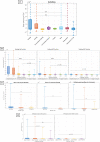Dental high-speed handpiece and ultrasonic scaler aerosol generation levels and the effect of suction and air supply
- PMID: 35938186
- PMCID: PMC10262170
- DOI: 10.1017/ice.2022.196
Dental high-speed handpiece and ultrasonic scaler aerosol generation levels and the effect of suction and air supply
Abstract
Objective: Exposure to aerosol spray generated by high-speed handpieces (HSHs) and ultrasonic scalers poses a significant health risk to oral health practitioners from airborne pathogens. Aerosol generation varies with different HSH designs, but to date, no study has measured this.
Materials and methods: We measured and compared aerosol generation by (1) dental HSHs with 3 different coolant port designs and (2) ultrasonic scalers with no suction, low-volume evacuation (LVE) or high-volume evacuation (HVE). Measurements used a particle counter placed near the operator's face in a single-chair, mechanically ventilated dental surgery. Volume concentrations of aerosol, totaled across a 0.3-25-µm size range, were compared for each test condition.
Results: HSH drilling and scaling produced significantly high aerosol levels (P < .001) with total volume concentrations 4.73×108µm3/m3 and 4.18×107µm3/m3, respectively. For scaling, mean volume of aerosol was highest with no suction followed by LVE and HVE (P < .001). We detected a negative correlation with both LVE and HVE, indicating that scaling with suction improved operator safety. For drilling, simulated cavity preparation with a 1-port HSH generated the most aerosol (P < .01), followed by a 4-port HSH. Independent of the number of cooling ports, lack of suction caused higher aerosol volume (1.98×107 µm3/m3) whereas HVE significantly reduced volume to -4.47×105 µm3/m3.
Conclusions: High concentrations of dental aerosol found during HSH cavity preparation or ultrasonic scaling present a risk of infection, confirming the advice to use respiratory PPE. HVE and LVE both effectively reduced aerosol generation during scaling, whereas the new aerosol-reducing 'no air' function was highly effective and can be recommended for HSH drilling.
Conflict of interest statement
All authors report no conflicts of interest relevant to this article.
Figures



Similar articles
-
Concern about the risk of aerosol contamination from ultrasonic scaler: a systematic review and meta-analysis.BMC Oral Health. 2024 Apr 5;24(1):417. doi: 10.1186/s12903-024-03996-2. BMC Oral Health. 2024. PMID: 38580933 Free PMC article.
-
Aerosol concentrations and size distributions during clinical dental procedures.Heliyon. 2022 Oct 18;8(10):e11074. doi: 10.1016/j.heliyon.2022.e11074. eCollection 2022 Oct. Heliyon. 2022. PMID: 36303931 Free PMC article.
-
Simulated and clinical aerosol spread in common periodontal aerosol-generating procedures.Clin Oral Investig. 2022 Sep;26(9):5751-5762. doi: 10.1007/s00784-022-04532-8. Epub 2022 May 17. Clin Oral Investig. 2022. PMID: 35581347 Free PMC article.
-
Aerosol reduction efficacy of different intra-oral suction devices during ultrasonic scaling and high-speed handpiece use.BMC Oral Health. 2022 Sep 6;22(1):388. doi: 10.1186/s12903-022-02386-w. BMC Oral Health. 2022. PMID: 36068515 Free PMC article.
-
A laboratory comparison of evacuation devices on aerosol reduction.J Dent Hyg. 2002 Summer;76(3):202-6. J Dent Hyg. 2002. PMID: 12271865 Review.
Cited by
-
Dental professionals' use of personal protective equipment during COVID-19: a cross-sectional study in China.Front Public Health. 2023 Jul 3;11:1183580. doi: 10.3389/fpubh.2023.1183580. eCollection 2023. Front Public Health. 2023. PMID: 37465172 Free PMC article.
-
Distribution characteristics of microbial aerosols and optimization of protective methods during ultrasonic scaling procedure.Sci Rep. 2025 Jun 4;15(1):19598. doi: 10.1038/s41598-025-04857-w. Sci Rep. 2025. PMID: 40467899 Free PMC article. Clinical Trial.
-
Reducing microbial airborne contamination and particulate matter using different oral suctions in dental clinic: A randomized controlled clinical trial.Saudi Dent J. 2024 Feb;36(2):374-380. doi: 10.1016/j.sdentj.2023.11.029. Epub 2023 Nov 28. Saudi Dent J. 2024. PMID: 38419981 Free PMC article.
-
Aerosol-generating procedures and associated control/mitigation measures: Position paper from the Canadian Dental Hygienists Association and the American Dental Hygienists' Association.Can J Dent Hyg. 2024 Feb 1;58(1):48-63. eCollection 2024 Feb. Can J Dent Hyg. 2024. PMID: 38505316 Free PMC article. Review.
-
Effectiveness of Preprocedural Mouthwashes: A Triple-Blind Randomised Controlled Clinical Trial.Int Dent J. 2025 Apr;75(2):868-876. doi: 10.1016/j.identj.2024.08.017. Epub 2024 Oct 6. Int Dent J. 2025. PMID: 39370336 Free PMC article. Clinical Trial.
References
-
- Samaranayake LP, Fakhruddin KS, Buranawat B, Panduwawala C. The efficacy of bioaerosol reducing procedures used in dentistry: a systematic review. Acta Odontol Scand 2020;79:69–80. - PubMed
-
- WHO coronavirus (COVID-19) dashboard. World Health Organization health emergency website. https://covid19.who.int/. Published 2022. Accessed March 27, 2022.
MeSH terms
Substances
LinkOut - more resources
Full Text Sources

